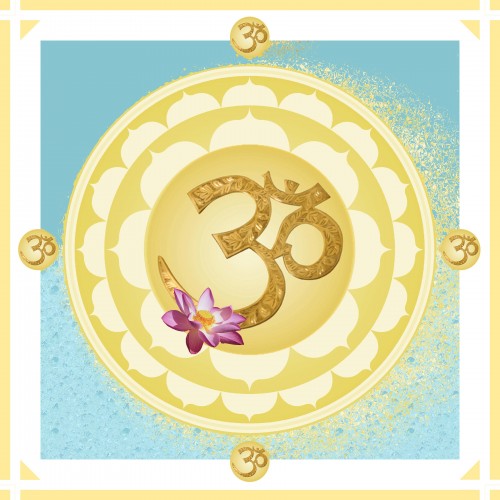
The Om Symbol – ॐ
The Om symbol is a symbol and also a word. The Om sound may be heard in the inner ear at any time. The duration of hearing the om sound may vary. The note is usually a high pitched sound. This sacred sound is the Divine Presence of God. The sound of om balances and clears the mind and uplifts the frequency of our personal self. The om sound is chanted for clearing personal space and for healing the body, mind and soul. Chanting om brings great inner peace and leads to deep meditation. For those who have never heard the om sound, begin by practicing to listen to the body’s inner motor sounds with the ear lobes closed with the middle fingers; while meditating on the spiritual eye. Concentrate on the sounds you hear and eventually you will be able to hear the om sound. Then it will come and fill your being with joy.
Paramahansa Yogananda refers to Om/Aum
The Premavatar Paramahansa Yogananda mentioned Om/Aum numerous times in his teachings; for example on page 277 of his “Autobiography of a Yogi”:”Patanjali speaks of God as the actual Cosmic Sound of Aum that is heard in meditation. Aum is the Creative Word, the whir of the Vibratory Motor, the witness of Divine Presence. Even the beginner in yoga may soon hear the wondrous sound of Aum.”
What is Om?
It is the smallest manŧra (मंत्र). It is also called pranav-manŧra. ‘Pranav’ (प्रणव) means primordial (मूल; mūl).
A manŧra is a phrase or word used for meditation and chanting.
A shlok (श्लोक) is a verse. The words ‘manŧra’ and ‘shlok’ have similar meaning. Example: Sacred ancient Indian texts like Ved (वेद), are collections of shlok/s. Some of these shlok/s are used as manŧra/s.
Manŧras usually begin with Om. The repetition of Om should be made with an understanding of it’s meaning.
Examples:
‘Om namah Shivāya’ – ॐ नमः शिवाय,
‘Om shānŧi shānŧi’ – ओम शांति शांति.
Jainism, Buđđhism and Sikhism originated from India after Hinđūism. These religions adopted some of the Hinđū philosophies and practices. These religions have their own unique form and understanding of Om.
Yogi’s understand Om as the vibration of God in form. The vibration of Om symbolizes the manifestation of God in form (sāguna brahman). Om is the reflection of the absolute reality, it is said to be “Adi Anadi”, without beginning or the end and embracing all that exists. The mantra Om is the name of God, the vibration of the Supreme. When taken letter by letter, A-U-M represents the divine energy (Shakti) united in its three elementary aspects: Bhrahma Shakti (creation), Vishnu Shakti (preservation) and Shiva Shakti (liberation, and/or destruction).
Early Vedantic Literature
The syllable Om is described as an all-encompassing mystical entity in the Upanishads. The syllable Om is mentioned in all the Upanishads, specially elaborated upon in the Taittiriya, Chāndogya and Māndukya Upanishad set forth as the object of profound religious meditation, the highest spiritual efficacy being attributed not only to the whole word but also to the three sounds a (a-kāra), u (u-kāra), m (ma-kāra), of which it consists. A-kara means form or shape like earth, trees, or any other object. U-kāra means formless or shapeless like water, air or fire. Ma-kāra means neither shape nor shapeless (but still exists) like the dark energy content of the Universe. When we combine all three syllables we get AUM which is a combination of A-kāra, U-kāra, and Ma-kāra.
The Katha Upanishad:
“The goal, which all Vedas declare, which all austerities aim at, and which humans desire when they live a life of conscience, I will tell you briefly it is aum”.
“The one syllable [evākṣara, viz. aum] is indeed Brahman. This one syllable is the highest. Whosoever knows this one syllable obtains all that he desires.
“This is the best support; this is the highest support. Whosoever knows this support is adored in the world of Brahma.” (1.2.15-17)
The Chāndogya Upanishad (1.1.1-1):
om ity-etad akṣaram udgītham upāsīta / aum iti hy udgāyati / tasyopavyākhyānam
“The udgi:tā [“the chanting”, that is, the syllable om] is the best of all essences, the highest, deserving the highest place, the eighth.”
The Bhagavad Gi:tā (8.13):
Uttering the monosyllable Aum, the eternal world of Brahman, One who departs leaving the body (at death), he attains the Supreme Goal (i.e., he reaches God).
In Bhagavad Gi:tā (9.17):
Lord Krishna says to Arjuna – “I am the father of this universe, the mother, the support and the grandsire. I am the object of knowledge, the purifier and the syllable oṃ. I am also the Ṛig, the Sāma and the Yajur Vedas.”
The Bhagvad Gi:tā (17.23):
om tatsatiti nirdesho brahmanstrividhah samratah
“OM, tat and sat has been declared as the triple appellation of Brahman, who is Truth, Consciousness and Bliss.”
The Meaning of Om or AUM
The Māndūkya Upaniṣhad
Twelve verses of the Vedic teaching called Māndūkya Upaniṣhad (माण्डूक्य उपनिषद) explains the sacred word ‘AUM’.
As per the Sanskṛiŧ grammar (Vyākaraṇ; व्याकरण) the vowel ‘O’ (ओ) is sometimes substituted for two consecutive vowels ‘A’ (अ) and ‘U’ (उ); ‘Om’ is also used instead of ‘AUm’ (अ-उ-म्).
Gāyaŧrī Manŧra (गायत्री मंत्र) like many other Vedik shlok/s starts with Om. It is understood that Om (ओम) means ‘O my (our) Lord’ (‘हे परमेश्वर’).
There is a relation between the words ‘Om’ and ‘Amen’. Om also means ‘Ma’ which also means ‘Mother’.
The Om symbol – ओंकार
The ‘Om symbol’ represents the Om’ sound.
The ‘Om symbol’ is called ‘On’kār’ (ओंकार) or ‘Omkār’ (ओम्-कार).
The ‘Om symbol’ is used for meditation and worship.
The ‘Om’ sound is written as ‘ओम’ in ĐevaNāgarī. So ‘ॐ’ is a symbol of the word ‘ओम’ in ĐevaNāgarī, Gujarati, Marathi, Nepali, and Hindi.
The ‘Om symbol’ is usually seen as ‘ॐ’.
